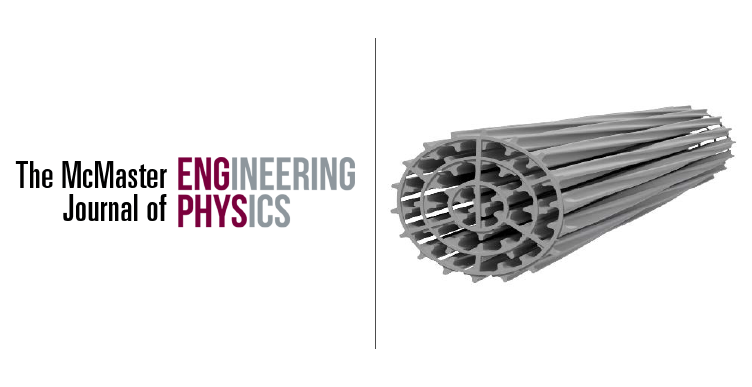Thickness Optimization of Ultra-thin Nickel Films
Abstract
Ultrathin nickel films with thicknesses varying from 2-7nm in 1nm increments were produced using electron-beam physical vapor deposition. Optical transmittance spectra were obtained using ellipsometry and Fourier transform infrared spectroscopy, and resistivities were obtained by measuring sheet resistance using a four-point probe setup. The Haacke's figure of merit was used to determine the optimal thickness of 3nm for those films produced, and a relative slope method was used along with fits to obtained data to determine a more precise optimum of 3.3nm. Differences in transmittance and resistivity from other sources were attributed to the lesser degree of compacting in the deposition method used when compared to dc sputtering. The results show that nickel thin films can be optimized by thickness to produce transparent conductive electrodes for optoelectronic applications.References
Klaus Ellmer. Past achievements and future challenges in
the development of optically transparent electrodes. Na-
ture Photonics, 6(12):809, December 2012. ISSN 1749-4893.
doi:10.1038/nphoton.2012.282. URL https://www.nature.com/
articles/nphoton.2012.282.
D. S. Ghosh, L. Martinez, S. Giurgola, P. Vergani, and
V. Pruneri. Widely transparent electrodes based on ultra-
thin metals. Optics Letters, 34(3):325{327, February 2009.
ISSN 1539-4794. doi:10.1364/OL.34.000325. URL https://www.
osapublishing.org/abstract.cfm?uri=ol-34-3-325.
Luis Martnez, Dhriti Sundar Ghosh, Stefano Giurgola, Paolo
Vergani, and Valerio Pruneri. Stable transparent Ni elec-
trodes. Optical Materials, 31(8):1115{1117, June 2009. ISSN
-3467. doi:10.1016/j.optmat.2008.11.019. URL http://www.
sciencedirect.com/science/article/pii/S092534670800311X.
Frank L. Pedrotti, Leno Matthew Pedrotti, and Leno S. Pedrotti.
Introduction to optics. Pearson/Prentice Hall, Upper Saddle
River, N.J, 3rd ed edition, 2007. ISBN 978-0-13-149933-1.
K. Fuchs. The conductivity of thin metallic lms according to
the electron theory of metals. Mathematical Proceedings of the
Cambridge Philosophical Society, 34(1):100{108, January 1938.
ISSN 1469-8064, 0305-0041. doi:10.1017/S0305004100019952.
URL https://www.cambridge.org/core/journals/
mathematical-proceedings-of-the-cambridge-philosophical-society/
article/conductivity-of-thin-metallic-films-according-to-the-electron-theory-of-metals/
B67FD21662E4DC38745343C4CF8455FD.
E.h. Sondheimer. The mean free path of electrons
in metals. Advances in Physics, 1(1):1{42, January
ISSN 0001-8732. doi:10.1080/00018735200101151.
URL http://www-tandfonline-com.libaccess.lib.mcmaster.
ca/doi/abs/10.1080/00018735200101151.
G. Haacke. New gure of merit for transparent conductors. Jour-
nal of Applied Physics, 47(9):4086{4089, September 1976. ISSN
-8979. doi:10.1063/1.323240. URL http://aip.scitation.
org.libaccess.lib.mcmaster.ca/doi/abs/10.1063/1.323240.
Simon G Kaplan and Leonard M Hanssen. Silicon as a stan-
dard material for infrared re
ectance and transmittance from 2
to 5 m. Infrared Physics & Technology, 43(6):389{396, Decem-
ber 2002. ISSN 1350-4495. doi:10.1016/S1350-4495(02)00161-
URL http://www.sciencedirect.com/science/article/pii/
S1350449502001615.
Dhriti Sundar Ghosh. Basics of Ultrathin Metal Films and Their
Use as Transparent Electrodes. In Ultrathin Metal Transpar-
ent Electrodes for the Optoelectronics Industry, Springer Theses,
pages 11{32. Springer, Heidelberg, 2013. ISBN 978-3-319-00347-4
-3-319-00348-1. URL https://link.springer.com/chapter/
1007/978-3-319-00348-1_2. DOI: 10.1007/978-3-319-00348-
2.
P. B. Johnson and R. W. Christy. Optical constants of transition
metals: Ti, V, Cr, Mn, Fe, Co, Ni, and Pd. Physical Review B, 9
(12):5056{5070, June 1974. doi:10.1103/PhysRevB.9.5056. URL
https://link.aps.org/doi/10.1103/PhysRevB.9.5056.
M. L. Grilli, I. Di Sarcina, S. Bossi, A. Rinaldi, L. Pil-
loni, and A. Piegari. Ultrathin and stable Nickel lms as
transparent conductive electrodes. Thin Solid Films, 594
(Part B):261{265, November 2015. ISSN 0040-6090. doi:
1016/j.tsf.2015.05.015. URL http://www.sciencedirect.
com/science/article/pii/S0040609015005490.
Bradley J. Pond, Tu Du, J. Sobczak, and Charles K.
Carniglia. Comparison of the optical properties of oxide
lms deposited by reactive-dc-magnetron sputtering with
those of ion-beam-sputtered and electron-beam-evaporated
lms. volume 2114, pages 345{355. International Society
for Optics and Photonics, July 1994. doi:10.1117/12.180926.
URL https://www-spiedigitallibrary-org.libaccess.lib.
mcmaster.ca/conference-proceedings-of-spie/2114/0000/
Comparison-of-the-optical-properties-of-oxide-films-deposited-by/
1117/12.180926.short.
Published
Issue
Section
License
Authors who publish with this journal agree to the following terms:Authors retain copyright and grant the journal right of first publication with the work simultaneously licensed under a Creative Commons Attribution License that allows others to share the work with an acknowledgement of the work's authorship and initial publication in this journal.
Authors are able to enter into separate, additional contractual arrangements for the non-exclusive distribution of the journal's published version of the work (e.g., post it to an institutional repository or publish it in a book), with an acknowledgement of its initial publication in this journal.
Authors are permitted and encouraged to post their work online (e.g., in institutional repositories or on their website) prior to and during the submission process, as it can lead to productive exchanges, as well as earlier and greater citation of published work.


